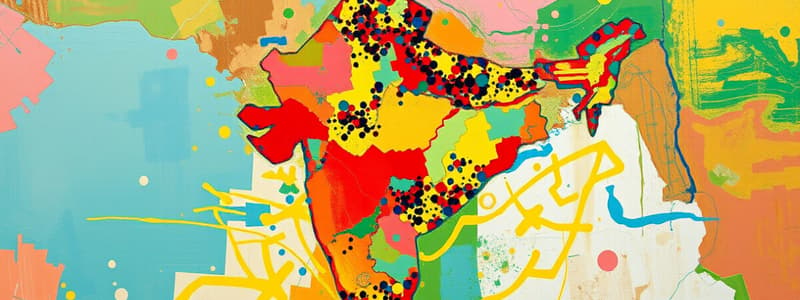Podcast
Questions and Answers
Which states together account for about 76 percent of the total population of India?
Which states together account for about 76 percent of the total population of India?
- U.P., Maharashtra, Bihar, West Bengal, Andhra Pradesh (correct)
- Tamil Nadu, Madhya Pradesh, Rajasthan, Karnataka, Gujarat (correct)
- All northern states of India
- All coastal states of India
What is the share of population in Arunachal Pradesh?
What is the share of population in Arunachal Pradesh?
- 1.04%
- 0.84%
- 0.11% (correct)
- 2.35%
Which physical factor is most influential in determining population distribution in India?
Which physical factor is most influential in determining population distribution in India?
- Terrain
- Climate
- Availability of water
- All of the above (correct)
What trend is observed in areas with the development of irrigation, like Rajasthan?
What trend is observed in areas with the development of irrigation, like Rajasthan?
Which historical factor significantly affects population distribution?
Which historical factor significantly affects population distribution?
In which regions of India is a larger proportion of the population concentrated?
In which regions of India is a larger proportion of the population concentrated?
What has contributed to the population concentration in areas previously thinly populated?
What has contributed to the population concentration in areas previously thinly populated?
Which of the following factors does NOT influence population distribution in India?
Which of the following factors does NOT influence population distribution in India?
What was the density of population in India in 2011?
What was the density of population in India in 2011?
Which Indian state has the highest population density?
Which Indian state has the highest population density?
What trend has been observed in the density of population over the last 50 years?
What trend has been observed in the density of population over the last 50 years?
Which of the following states has a density lower than that of Kerala?
Which of the following states has a density lower than that of Kerala?
Among the following, which pair shows the population densities of northern states in India correctly?
Among the following, which pair shows the population densities of northern states in India correctly?
Which of the following regions in India generally has low population density?
Which of the following regions in India generally has low population density?
What is the main purpose of calculating physiological and agricultural densities?
What is the main purpose of calculating physiological and agricultural densities?
Which of the following cities does NOT have a high concentration of population due to industrial development?
Which of the following cities does NOT have a high concentration of population due to industrial development?
Flashcards are hidden until you start studying
Study Notes
Population Distribution in India
- U.P., Maharashtra, Bihar, West Bengal, Andhra Pradesh, Tamil Nadu, Madhya Pradesh, Rajasthan, Karnataka, and Gujarat together account for approximately 76% of India's total population.
- States with minimal population share include Jammu & Kashmir (1.04%), Arunachal Pradesh (0.11%), and Uttarakhand (0.84%), despite large geographical areas.
- Uneven population distribution is influenced by physical, socio-economic, and historical factors.
Physical Factors Influencing Population
- Climate, terrain, and water availability significantly affect population patterns.
- Higher population concentrations found in North Indian Plains, deltas, and Coastal Plains compared to southern and central interior districts, Himalayas, and some northeastern and western states.
- Development of irrigation, mineral and energy resources, and transport networks have boosted population density in areas that were previously thinly populated.
Socio-Economic and Historical Factors
- Key socio-economic factors include the evolution of settled agriculture, development of human settlements, transport networks, industrialization, and urbanization.
- River plains and coastal areas have historically supported larger populations due to early human settlement and developed transport systems.
- Major urban centers like Delhi, Mumbai, Kolkata, Bengaluru, Pune, Ahmedabad, Chennai, and Jaipur experience high population densities due to industrial development and rural-to-urban migration.
Density of Population
- Population density is measured as the number of persons per unit area, crucial for understanding spatial population distribution.
- In 2011, India had a population density of 382 persons per sq km, a significant increase from 117 persons per sq km in 1951.
- Population density varies widely, from 17 persons per sq km in Arunachal Pradesh to 11,297 in Delhi.
- Northern states like Bihar (1102), West Bengal (1029), and Uttar Pradesh (828) have high densities; Kerala (859) and Tamil Nadu (555) are among high-density peninsular states.
- Himalayan and northeastern states exhibit low densities, while Union Territories (excluding Andaman and Nicobar Islands) have high population densities.
Understanding Human-Land Relationship
- Density serves as a crude measure of human-land relationship; to gain deeper insights, physiological and agricultural densities should be considered.
- These densities are particularly significant given India's large agricultural population, highlighting the pressure of population on cultivable land.
Studying That Suits You
Use AI to generate personalized quizzes and flashcards to suit your learning preferences.




